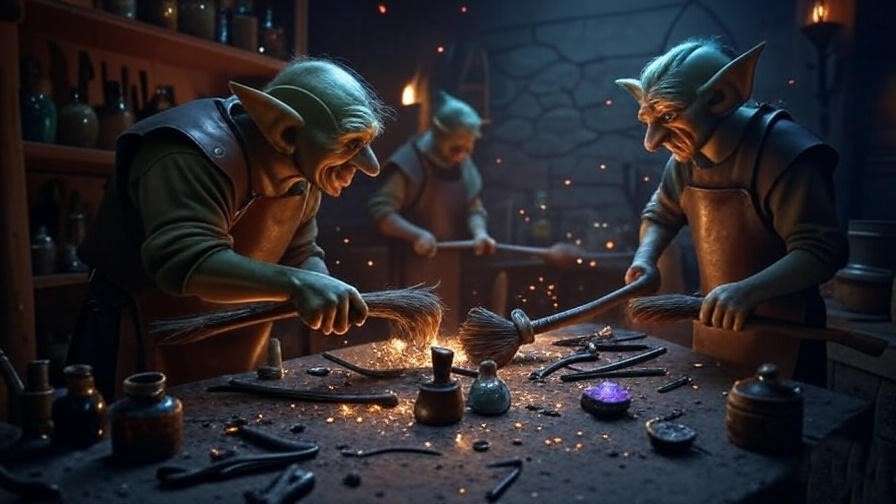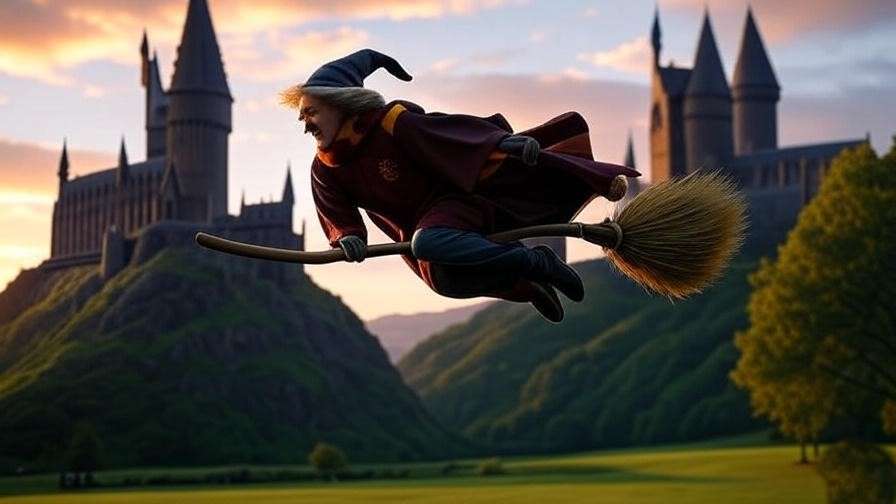Picture yourself soaring above the Hogwarts Quidditch pitch, the roar of the crowd below, as you grip your broomstick, chasing the Golden Snitch. In the magical world of Harry Potter, broom types define a wizard’s prowess, style, and status. Whether you’re a fan diving into Quidditch lore, a cosplayer crafting the perfect replica, or a gamer choosing your virtual ride, understanding Harry Potter broom types is key to unlocking the magic of flight. This ultimate guide explores every major broom, its features, and its role in J.K. Rowling’s universe, offering expert insights to help you choose the perfect broom.
Drawing from Quidditch Through the Ages and the Wizarding World archives, we’ll uncover the history, craftsmanship, and performance of iconic brooms like the Nimbus 2000, Firebolt, and Comet series. Whether you’re a Gryffindor Seeker or a Hufflepuff enthusiast, this article will answer your questions and spark your imagination. Let’s dive into the enchanting world of wizarding broomsticks!
The Magical World of Broomsticks in Harry Potter
A Brief History of Broomsticks in the Wizarding World
Broomsticks have been a cornerstone of wizarding culture for centuries, evolving from rudimentary twigs to sleek, spell-infused machines. According to Quidditch Through the Ages, the earliest brooms, used in the 10th century, were crude and uncomfortable, often causing more splinters than speed. By the 19th century, advancements in magical craftsmanship introduced models like the Oakshaft 79 and Silver Arrow, setting the stage for modern broom design. These innovations transformed brooms into essential tools for transportation, sport, and even cultural expression, making them as iconic as wands in the Harry Potter series.
Why Broom Types Matter
In the wizarding world, a broom is more than a tool—it’s a reflection of a wizard’s identity. Harry Potter’s Nimbus 2000, a gift from Professor McGonagall, symbolized his destiny as a Seeker, while Draco Malfoy’s Nimbus 2001 flaunted his family’s wealth. Different Harry Potter broom types cater to specific needs: speed for Quidditch stars, durability for team players, or affordability for students. For fans, understanding these brooms enhances appreciation of the series, informs cosplay choices, and enriches gameplay in titles like Hogwarts Legacy. Choosing the right broom can make or break your Quidditch game—or your wizarding aesthetic.
Major Harry Potter Broom Types: Features and Performance
The Comet Series
The Comet series, produced by the Comet Trading Company, is the go-to choice for wizards seeking affordability without sacrificing reliability. The Comet 140, introduced in the 1920s, was a game-changer for its time, offering decent speed and handling for casual fliers. Its successor, the Comet 260, gained fame through Cho Chang, Ravenclaw’s Seeker, who used it in Harry Potter and the Prisoner of Azkaban. With a top speed of around 60 mph and a reliable Cushioning Charm, the Comet 260 is ideal for Hogwarts students or recreational players. However, it lags behind premium models in acceleration and agility, making it less suited for professional Quidditch.
Pros: Budget-friendly, reliable for beginners, widely available.
Cons: Slower than high-end models, limited maneuverability.
The Nimbus Series
The Nimbus Racing Broom Company set the gold standard with its Nimbus series, known for speed and precision. The Nimbus 2000, Harry’s first broom, was a marvel in Harry Potter and the Philosopher’s Stone, boasting a top speed of 100 mph, superb balance, and a sleek mahogany finish. Its successor, the Nimbus 2001, used by the Slytherin team, offered slight improvements in acceleration, as Draco Malfoy smugly demonstrated. These brooms excel in Quidditch, particularly for Seekers and Chasers, but their high cost and occasional durability issues (like Harry’s Nimbus 2000 meeting the Whomping Willow) are drawbacks.

Pros: Elite speed, excellent handling, prestigious brand.
Cons: Expensive, less durable under extreme conditions.
The Firebolt
The Firebolt is the pinnacle of broomstick engineering, a masterpiece unveiled in Harry Potter and the Prisoner of Azkaban. Crafted with goblin-iron reinforcements and an ash handle polished to perfection, it reaches speeds of 150 mph in seconds, with unmatched stability and precision. Gifted to Harry by Sirius Black, the Firebolt powered his triumphs in Goblet of Fire and was favored by the Irish National Quidditch Team. Its Braking Charm and aerodynamic design make it the ultimate choice for professional players, though its astronomical price—rumored to be hundreds of Galleons—puts it out of reach for most.

Pros: Unrivaled speed, perfect balance, durable construction.
Cons: Prohibitively expensive, overkill for casual fliers.
Other Notable Brooms
Beyond the big three, several brooms have left their mark. The Cleansweep series, like the Cleansweep 11, is a staple for Hogwarts house teams, offering durability for Beaters and Keepers. The Silver Arrow, a vintage model from the mid-20th century, was admired for its elegance but lacked modern speed. Historical brooms like the Oakshaft 79, built for endurance, and the Moontrimmer, designed for altitude, appear in Quidditch Through the Ages as precursors to today’s designs. These models appeal to collectors and historians, adding depth to the wizarding world’s broom lore.

How Broom Types Influence Quidditch Performance
Speed vs. Control: What Makes a Great Quidditch Broom?
In Quidditch, a broom’s attributes—speed, agility, and stability—determine a player’s success. Seekers like Harry need lightning-fast brooms like the Firebolt to chase the Snitch, while Beaters require durable models like the Cleansweep for aggressive play. Chasers benefit from balanced brooms like the Nimbus 2000, which offer both speed and maneuverability. Stability is crucial for Keepers, who need precise control to guard the hoops. Quidditch Through the Ages notes that broom choice often tips the scales in professional matches, where milliseconds matter.

Iconic Quidditch Moments and Their Brooms
Broom types shine in the series’ most memorable Quidditch scenes. In Philosopher’s Stone, Harry’s Nimbus 2000 outmaneuvered opponents to secure Gryffindor’s victory. The Firebolt’s debut in Prisoner of Azkaban showcased its superiority, helping Harry evade Dementors and catch the Snitch. The Nimbus 2001, used by Slytherin in Chamber of Secrets, highlighted the arms race in broom technology, though Harry’s skill ultimately prevailed. These moments underscore how broom performance shapes the drama and excitement of Quidditch.
Expert Tip: Choosing a Broom for Your Quidditch Position
For fans imagining their Quidditch role, broom choice depends on play style. Seekers should prioritize speed (Firebolt or Nimbus 2000), Chasers need balance (Nimbus series), and Beaters and Keepers benefit from durability (Cleansweep or Comet). If you’re a beginner, start with a Comet 260 for affordability and ease. Cosplayers might choose a broom for aesthetics—say, the Firebolt’s sleek ash handle for a heroic look or the Nimbus 2001 for a Slytherin vibe.
Broomstick Craftsmanship and Magical Engineering
How Brooms Are Made
Crafting a broomstick in the wizarding world is a blend of artistry and magic, as detailed in Quidditch Through the Ages. The process begins with selecting high-quality wood—ash for the Firebolt’s strength, mahogany for the Nimbus 2000’s elegance, or hazel for the Comet’s affordability. Artisans then shape the wood, ensuring aerodynamic precision. Magical elements, like goblin-iron reinforcements in the Firebolt, add durability and balance. Charms are meticulously applied, with each broom receiving a unique combination of spells tailored to its purpose. This intricate process, honed over centuries, ensures brooms are both functional and enchanting.
Key Manufacturers
The wizarding world’s broom industry is dominated by a few key players. The Nimbus Racing Broom Company revolutionized broom design with its focus on speed and precision, producing the iconic Nimbus 2000 and 2001. The Comet Trading Company caters to the masses, offering reliable models like the Comet 260. The Cleansweep Broom Company specializes in durable, team-oriented brooms, such as the Cleansweep 11, favored by Hogwarts houses. Smaller manufacturers, like the Ellerby and Spudmore company behind the Tinderblast, contribute niche models. Each brand’s innovations have shaped Quidditch and wizarding travel.
Magical Charms Behind Broom Flight
A broom’s ability to fly relies on a suite of magical charms. The Cushioning Charm, pioneered by Jocunda Sykes, ensures a smooth ride, critical for long flights or intense Quidditch matches. The Braking Charm, perfected in the Firebolt, allows precise stops and turns, giving Seekers like Harry an edge. Levitation and propulsion spells, often proprietary to manufacturers, provide lift and speed. These charms, combined with expert craftsmanship, make brooms responsive and safe, whether navigating a stormy pitch or cruising above Diagon Alley.
Broomsticks Beyond Quidditch: Cultural and Practical Uses
Brooms in Everyday Wizarding Life
Beyond the Quidditch pitch, broomsticks are a primary mode of transportation in the wizarding world. Wizards like Hagrid use them for cross-country travel, as seen in Harry Potter and the Philosopher’s Stone when he retrieves baby Harry. Brooms also serve adventurous purposes, like exploring magical landscapes or, in rare cases, smuggling goods (as hinted in Goblet of Fire). Culturally, brooms are status symbols—Sirius Black’s gift of a Firebolt to Harry underscored its prestige. For fans, this versatility makes brooms a fascinating aspect of wizarding life.
Brooms in the Wizarding Economy
Broomsticks span a wide price range, reflecting their role in the wizarding economy. A Comet 260 might cost a few dozen Galleons, affordable for students, while a Firebolt’s price, rumored to be hundreds of Galleons, rivals luxury items like rare wands. Draco Malfoy’s purchase of Nimbus 2001s for the entire Slytherin team in Chamber of Secrets showcased wealth and influence. For fans, understanding these economics adds depth to the series and informs collectible purchases, as high-end broom replicas command premium prices in the Muggle world.
Fan Application: Brooms in Cosplay and Collectibles
For Harry Potter fans, brooms are a cosplay and collectible staple. A Firebolt replica, with its polished ash handle, elevates a Harry Potter costume, while a Nimbus 2001 suits a Draco-inspired look. Crafting tips: Use lightweight materials like foam or wood for authenticity, and add metallic accents for goblin-iron details. Officially licensed replicas are available through the Wizarding World shop or retailers like Noble Collection. For collectors, vintage-inspired models like the Silver Arrow are prized for their historical charm, making them perfect display pieces.

Comparing Harry Potter Broom Types: Which Is Right for You?
Side-by-Side Comparison
To help you choose, here’s a comparison of key Harry Potter broom types:
| Broom | Top Speed | Handling | Cost | Durability | Notable Users |
|---|---|---|---|---|---|
| Comet 260 | 60 mph | Moderate | Low | High | Cho Chang |
| Nimbus 2000 | 100 mph | Excellent | High | Moderate | Harry Potter |
| Nimbus 2001 | 105 mph | Excellent | Very High | Moderate | Draco Malfoy, Slytherin |
| Firebolt | 150 mph | Perfect | Luxury | Very High | Harry Potter, Irish Team |
| Cleansweep 11 | 70 mph | Good | Moderate | High | Hogwarts Teams |
Who Should Use Each Broom?
- Students/Beginners: The Comet 260 is affordable and easy to handle, perfect for Hogwarts Flying Lessons.
- Quidditch Seekers/Chasers: The Nimbus 2000 or Firebolt offers speed and agility for competitive play.
- Beaters/Keepers: The Cleansweep 11’s durability suits aggressive or defensive roles.
- Cosplayers/Collectors: Choose based on character alignment (e.g., Firebolt for Harry, Nimbus 2001 for Draco) or aesthetic appeal.
Expert Insight: What Would Harry Choose Today?
If Harry were choosing a broom today, the Firebolt would likely remain his top pick for its unmatched performance, aligning with his daring Seeker style. However, a modern equivalent might blend Firebolt speed with eco-friendly charms, reflecting Harry’s care for the wizarding world. For fans, this suggests prioritizing a broom that matches your personality—speed for thrill-seekers, reliability for steady players.
Common Questions About Harry Potter Broom Types (FAQ)
What Is the Fastest Broom in Harry Potter?
The Firebolt is the fastest, reaching 150 mph in seconds, as seen in Goblet of Fire when Harry outpaces opponents at the Quidditch World Cup. Its goblin-iron frame and advanced charms make it unrivaled.
Are Older Brooms Like the Silver Arrow Still Usable?
While the Silver Arrow was groundbreaking in its era, its slower speed and outdated charms make it impractical for modern Quidditch. Collectors value it for nostalgia, but it’s no match for a Nimbus or Firebolt.
How Much Would a Firebolt Cost in Real Money?
Estimating from the wizarding economy, where 1 Galleon ≈ $5-$10, a Firebolt’s cost (hundreds of Galleons) could equate to $2,000-$5,000 in Muggle currency, akin to a high-end motorcycle.
Can Muggle-Born Wizards Use Brooms Effectively?
Absolutely. Hogwarts’ Flying Lessons, led by Madam Hooch, ensure all students, including Muggle-borns, master broom flight. Talent, not heritage, determines skill—Harry’s natural ability proves this.
Fun Facts and Trivia About Harry Potter Broom Types
- The Firebolt’s goblin-iron frame was inspired by ancient wizarding armor, blending magic and metallurgy.
- The Nimbus 2000’s destruction by the Whomping Willow in Prisoner of Azkaban left fans heartbroken, symbolizing Harry’s loss of innocence.
- The Moontrimmer, a 1901 model, was designed by a witch, Gladys Boothby, highlighting female contributions to broomcraft.
- In the films, broom designs were subtly altered for visual flair, with the Firebolt sporting a more angular look than described in the books.
From the budget-friendly Comet 260 to the elite Firebolt, Harry Potter broom types offer a window into the wizarding world’s magic, technology, and culture. Whether you’re a Quidditch fan analyzing performance, a cosplayer crafting a replica, or a collector seeking rare models, understanding these brooms deepens your connection to J.K. Rowling’s universe. Explore Quidditch Through the Ages for more lore, or check out Wizarding World’s official merchandise for authentic replicas. Which broom would you choose for your Hogwarts Quidditch team? Share in the comments and let the magic of flight inspire you!













